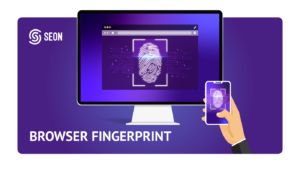Browser fingerprinting serves as the cornerstone of device intelligence, allowing companies to distinctly recognise visitors on their websites globally; for organisations aiming to improve how they identify visitors, grasping the different methods of browser fingerprinting is essential. A precise identifier aids developers in assessing potentially harmful traffic and limiting access to those attempting unauthorised account access, making fraudulent transactions, or spamming the site. Additionally, it contributes to customising user experiences while providing deeper insights into visitor behaviours.

In this article, we will explore browser fingerprinting, examine the prevalent techniques associated with it, and discuss its application in fraud detection.
So, what exactly is browser fingerprinting? It comprises a range of tools and methodologies designed to collect data based on a web user’s online activities. This process captures various aspects such as the user’s operating system, browser type, screen resolution, time zone settings, keyboard layout, and more. By analysing these elements together, a unique identifier—often referred to as a digital fingerprint—is generated for each user. This identifier remains stable across different browsing sessions, offering a dependable means of recognising visitors that goes beyond traditional cookie tracking.
For businesses leveraging this technology, browser fingerprinting presents numerous benefits. It facilitates more precise and consistent visitor identification while enhancing personalisation efforts for users and refining fraud detection models. By gaining insight into a visitor’s unique browser fingerprint, companies can better align their websites and applications with audience preferences—ultimately boosting visitor satisfaction and conversion rates.
Moreover, one significant advantage is its role in preventing fraud. Browser fingerprinting can be instrumental in identifying and blocking users whose behaviour appears dubious or suspicious.
Cookies and Fingerprints: A Tale of Identification
When a visitor first arrives at your website, a cookie is created, embedding a unique identifier hash into their browser. This little piece of data serves as a digital signature; if the same visitor returns and their cookie aligns with an entry in your database, you can confidently assert that it’s the same person. Yet, cookies are notoriously easy to hide or delete. In instances where users deliberately block cookies or seek to mask their identity, browser fingerprinting emerges as a powerful alternative that can identify individuals with impressive accuracy.

Now, let’s explore the distinction between browser fingerprinting and device fingerprinting. Mobile device fingerprinting collects various pieces of information about a user’s device—such as its operating system and hardware specifications—and synthesises this data into a unique identifier for each gadget. The signals used in this process differ from those gathered through browsers and can vary significantly across platforms like iOS and Android. Notably, apps can leverage these fingerprints to recognise devices even after clearing app caches or data.
How does browser fingerprinting actually function? It operates by meticulously gathering and analysing an array of data points—or signals—from both the visitor’s web browser and device. This intricate process is designed to detect subtle distinctions between different visitors’ browsers, even when they are using identical models or operating systems. The strength of browser fingerprinting lies in its capacity to create what is known as a high entropy identifier; essentially, it generates an intricate profile that sets one user apart from millions online.
Consider this: while many visitors may be running the same version of an operating system, factors such as installed software variations, specific browser settings, and even slight hardware differences contribute to crafting a unique fingerprint for each user. This sophisticated method allows for unparalleled precision in identifying visitors—far surpassing traditional identification methods—and opens up new avenues for understanding who your audience truly is.

What kind of data is collected? The signals or characteristics involved in this process encompass a variety of factors, including, but not limited to, the type and version of the web browser, the operating system and its version, screen resolution and colour depth, installed fonts and plugins, time zone and language preferences, as well as the use of ad blockers. These signals are gathered through scripts that operate silently in the background of a visitor’s browser. They meticulously analyse both software and hardware configurations without disrupting or altering the user experience. This results in a fingerprint—a unique amalgamation of these attributes that creates an exceptionally distinctive profile capable of identifying the visitor across various browsing sessions. Notably, this technique remains effective even when conventional identification methods such as cookies are circumvented by incognito browsing or cleared browser data.
Fingerprinting technology utilises advanced methods for browser identification to collect over 70 distinct signals. These signals are then synthesised with server-side analysis and deduplication processes to produce a visitor identifier—a persistent yet valuable representation of a browser fingerprint that can change if users modify their settings or update their device software.
Multiple techniques are available for crafting an effective fingerprint for website visitors. Among them are canvas fingerprinting, WebGL fingerprinting, media device fingerprinting, TLS fingerprinting, font fingerprinting, mobile fingerprinting, and audio fingerprinting. Below is an exploration of each method.
Canvas fingerprinting is one such technique; it leverages the HTML5 canvas element to detect differences in a user’s GPU (graphics processing unit), graphics drivers, or graphics card specifications. Initially, a script generates an image—often layered with text—and subsequently captures how the user’s web browser renders this image along with its textual overlay. Naturally, variations in hardware and drivers will lead to distinct rendering outcomes across different devices.
AmIUnique has utilised Canvas and WebGL to produce images that reveal a visitor’s unique browser and device characteristics. Due to the specific way these images are rendered, they can be traced back to less than 0.01% of all visitors.

WebGL fingerprinting is a sophisticated form of browser fingerprinting that leverages the capabilities of the Web Graphics Library (WebGL). This technology enables the rendering of intricate three-dimensional graphics directly within a web browser, eliminating the need for any external plugins. The process works by directing the browser to create detailed off-screen images, which are then scrutinised for their unique features.
Graphics rendering can differ significantly across various combinations of hardware configurations, including graphics drivers and GPUs (Graphics Processing Units). The WebGL fingerprinting method starts with a script that instructs the browser to generate a specific 3D graphic that remains hidden from view. Although these images may appear uniform at first glance, they harbour subtle variations that depend on individual hardware characteristics.
These discrepancies arise from how different devices’ GPUs and drivers interpret and execute WebGL commands. For instance, two devices equipped with different GPU models or even varying driver versions for an identical GPU will yield slightly distinct image outputs due to differences in rendering algorithms and hardware performance. By examining these nuanced variations in rendered images, WebGL can create a unique identifier for each device.

On another front, media device fingerprinting identifies all connected media devices along with their respective IDs on a user’s laptop or PC. This encompasses internal components such as video cards and audio cards as well as any connected peripherals like headphones. However, media device fingerprinting is not commonly employed in broader fingerprinting practices because it necessitates user permission to access their microphone or other sensitive components.
Font Fingerprinting
Font fingerprinting serves as a technique for recognizing users on the internet by analyzing the unique collection of fonts that are installed on their devices. This process involves websites running scripts to determine which fonts are available on a visitor’s machine, thereby creating a one-of-a-kind profile based on these font selections. Given that people typically have a mix of standard system fonts and those they’ve added themselves, this results in a distinct fingerprint capable of distinguishing one user from another. This method proves particularly beneficial for web analytics and tailored content delivery, allowing websites to recognize returning visitors and gain insights into their preferences without depending on conventional cookies. Ultimately, this enhances the overall user experience through personalized interactions.

Mobile Device Fingerprinting
In a manner akin to browser fingerprinting, mobile device fingerprinting is employed to identify specific devices by examining a unique blend of hardware and software characteristics. This technique gathers various data points—such as the operating system of the device, browser type, screen resolution, and more—to construct an individual profile or fingerprint for that device. It operates by scrutinizing these features without relying on traditional tracking methods like cookies. Mobile device fingerprinting is especially advantageous for businesses and online services since it allows them to recognize returning devices, personalize user experiences effectively, and bolster fraud detection efforts by pinpointing devices that display unusual activity. This approach provides a dependable means to gauge user engagement while optimizing services accordingly.

Audio Fingerprinting
Audio fingerprinting functions by analyzing the subtle variations in how audio content is rendered through different software and hardware setups within a device. When sound is played back, elements such as the browser’s brand and version alongside the CPU architecture play crucial roles in shaping how sound waves are produced and processed. Through this analysis of audio characteristics, systems can effectively identify specific sounds or tracks with remarkable accuracy.

Unmasking Fraudulent Activity

When it comes to the challenge of detecting and preventing fraud, it’s crucial to remember that a mere fraction of your website visitors are behind these deceptive actions. To tackle this issue, your development team must devise a strategy to pinpoint these problematic users. This involves identifying them, verifying their identities through authentication processes, and ultimately placing them on a blocklist for your site. However, it’s essential to ensure that these security measures do not interfere with the experience of genuine users; excessive authentication can hinder their interaction with your site. Moreover, heightened security protocols may inadvertently delay account access, lower conversion rates, and diminish overall user engagement.
Moving Beyond Conventional Concealment Strategies
Browser fingerprinting emerges as an effective tool for recognizing visitors who exhibit suspicious behaviour patterns. This technique allows you to focus additional security efforts solely on these individuals. Fraudsters frequently employ tactics to mask their identities—such as disabling cookies, using VPNs, or browsing in incognito mode—which can complicate detection efforts. Here’s where fingerprinting shines: it enables rapid identification of users without depending on IP addresses or cookies.

Stopping Account Takeovers in Their Tracks
One prevalent form of fraud is account takeover—a scenario where malicious actors attempt to hijack legitimate users’ accounts for illicit purchases or identity theft. By leveraging fingerprinting along with other user identification technologies, you can enhance the login process for traffic deemed suspicious. This added layer of security complicates matters for untrustworthy visitors attempting to access and seize control of authentic accounts.
Defending Against Brute Force and Bot Attacks

Implementing browser fingerprinting techniques can significantly bolster defences against brute force assaults and bot activities—far surpassing traditional methods like CAPTCHA or temporary account lockouts. By recognising distinctive browser fingerprints, websites can efficiently detect and flag repeated login attempts that display characteristics typical of automated bots or brute force strategies.
How Maxthon Prevents Fraud Using Browser Fingerprinting Techniques
1. Understanding Browser Fingerprinting
Maxthon utilises browser fingerprinting to create a unique profile for each user based on their device characteristics, settings, and behaviours. This method collects data such as browser type, installed fonts, screen resolution, and even time zone.

2. Data Collection and Analysis
The gathered information is analysed in real-time to detect inconsistencies or unusual patterns that may indicate fraudulent activity. By developing a comprehensive profile for users, Maxthon can better identify anomalies.
3. Adaptive Security Measures
When suspicious behaviour is detected, Maxthon triggers adaptive security protocols. These measures could include requiring additional verification steps or temporarily restricting access until the user’s identity is confirmed.
4. Machine Learning Integration
To enhance its fraud detection capabilities, Maxthon employs machine learning algorithms. These algorithms continuously learn from new data patterns, allowing for improved accuracy in identifying potential threats.
5. User Privacy Protection
While implementing these techniques, Maxthon prioritises user privacy by anonymising collected data where possible and ensuring compliance with relevant privacy regulations.
6. Real-time Alerts for Users
If fraudulent activities are detected associated with a user’s profile, Maxthon promptly sends real-time alerts to notify users and provide necessary actions they should take.
7. Collaboration with Security Experts
Maxthon collaborates with cybersecurity professionals to stay updated on emerging fraud tactics and refine its detection strategies accordingly.
8. User Education on Security Practices
To empower users against fraud attempts, Maxthon provides educational resources on safe browsing practices and recognising phishing threats.
9. Continuous Improvement Feedback Loop
Finally, users’ feedback on their experiences is actively sought to continuously enhance the effectiveness of fingerprinting techniques, creating a more secure browsing environment for everyone.
